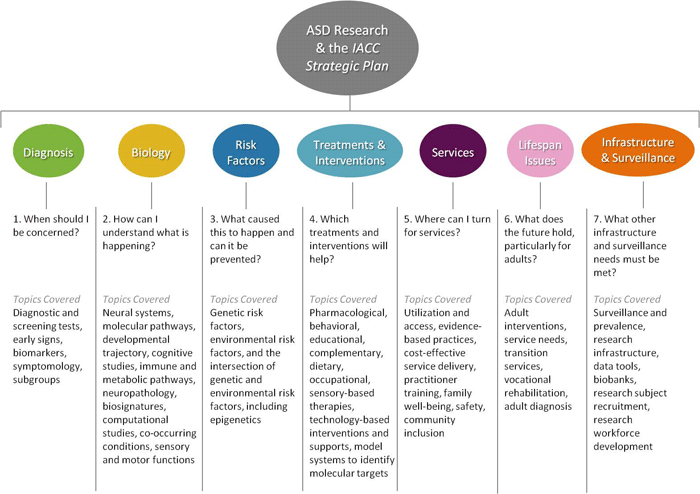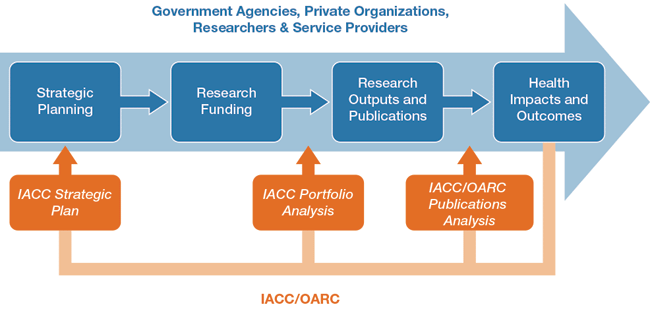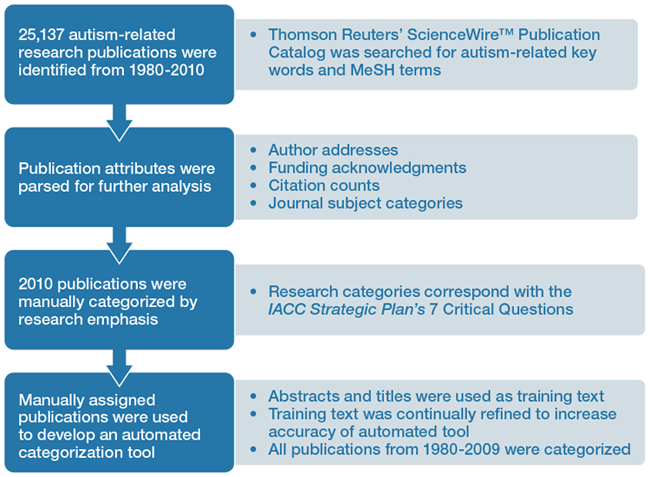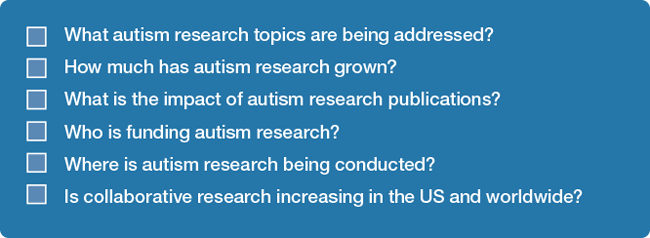Publications Analysis
Autism Spectrum Disorder Research
The Global Landscape of Autism Research
2012
The Interagency Autism Coordinating Committee: Mission and Strategic Plan
Two decades ago, autism – a developmental disorder appearing in early childhood and characterized by restricted or repetitive behaviors and impairments in language and social communication – was a little known and rarely diagnosed disorder. Today, with an estimated prevalence of 1 in 88 children in the US, autism spectrum disorder (ASD) has become a top national health priority in the US.1 In addition, growing recognition of the global impact of ASD has stimulated collaborative efforts of government agencies and private organizations worldwide to fund autism research.
Increasing awareness of the impact of ASD on individuals, families, and society, as well as expanding knowledge of the biological underpinnings of ASD, has driven the rapid advancement of ASD research in recent years. Key priorities reflecting the urgent needs of the community include finding ways to (1) diagnose ASD earlier, (2) understand the underlying biology and risk factors associated with ASD, and (3) develop effective treatments, interventions, services and supports that can reduce disability and enhance quality of life for affected individuals and families across the lifespan. With the anticipated large number of children, adolescents, and adults on the autism spectrum who will be in need of treatments, interventions, and services in the future, as well as supports to assist them in integrating into their communities, the pressing need for scientific insight and breakthrough research across multiple disciplines has never been greater.
To better coordinate US Federal agency efforts addressing the needs of the autism community, Congress enacted the Combating Autism Act (CAA) of 2006 (PDF – 142 KB) and the Combating Autism Reauthorization Act (CARA) of 2011 (PDF – 121 KB), establishing and subsequently reauthorizing the Interagency Autism Coordinating Committee (IACC).i The IACC, a Federal advisory committee composed of Federal officials representing agencies engaged in autism activities as well as members of the public stakeholder community, is charged with developing and updating annually a strategic plan to guide Federal investments in autism research, monitoring research activities and progress, and communicating information about advances in autism research to Congress and the public. The IACC also provides advice to the Secretary of HHS regarding Federal autism activities and provides a forum for public participation in the dialogue about issues that affect the autism community and the subsequent development of policy to meet community needs.
The IACC Strategic Plan for Autism Spectrum Disorder Research, first released in 2009 and updated in 2010 and 2011, is intended to accelerate and inspire research that will improve profoundly the health and well-being of individuals on the autism spectrum across the lifespan as well as serve as a blueprint for Federal activities and public-private partnerships in ASD research. The IACC Strategic Plan was developed with extensive input from the public, including self-advocates, parents, advocacy organizations, researchers, educators, service providers, and other key community stakeholders. This broad input enabled the development of a plan that spans the range of needs across the autism community.
The annual updates to the IACC Strategic Plan reflect important new advances in the ASD research field as well as emerging areas of opportunity and need. Figure 1 summarizes the seven research areas and corresponding Critical Questions of the 2011 IACC Strategic Plan, including the major topics within each.2
The Seven IACC Strategic Plan Critical Questions and Corresponding Research Areas

Figure 1. The Seven IACC Strategic Plan Critical Questions and Corresponding Research Areas. The research areas corresponding to the seven Critical Questions of the 2011 IACC Strategic Plan for ASD Research are designated in the oval above each question, and a list of topics covered in each section is provided below each Critical Question. The list addresses most of the topics covered within each Critical Question area but is not necessarily comprehensive.
The IACC Strategic Plan emphasizes the need for consumer-focused research that addresses the most pressing questions of people and families living with ASD. The needs of the collective autism community are vast and varied and include:
- Recognizing the symptoms and signs of autism early to enable early intervention and maximize potential to reduce disability (Diagnosis
 )
) - Understanding the biological underpinnings that help explain autism symptoms and can serve as a foundation for research advances (Biology
 )
) - Identifying genetic and environmental risk factors (Risk Factors
 )
) - Developing an array of treatments and interventions that are safe and effective for use across the lifespan (Treatments and Interventions
 )
) - Ensuring that high-quality, evidence-based services and supports are available and accessible to everyone who needs them (Services
 )
) - Recognizing that autism can result in changing needs and disability throughout life and that research is needed to understand and meet the needs of all people with autism across the lifespan (Lifespan Issues
 )
) - Developing the infrastructure of the autism research field to coordinate, accelerate, and increase the effectiveness of autism research; and improving autism surveillance efforts to enable more accurate assessment of ASD prevalence in populations in the US and worldwide (Infrastructure and Surveillance
 )
)
Within each of the seven Strategic Plan Critical Question areas, the IACC identified numerous specific objectives they believed would advance research, fill key knowledge gaps, and build a foundation for the development of practical tools, interventions, and services to positively impact the lives of people with autism and their families.
The Office of Autism Research Coordination (OARC), an office within the National Institutes of Health (NIH), was established to support the work and mission of the IACC. To assist the IACC in fulfilling its research monitoring function, OARC tracks how US research grants and contracts align with the IACC Strategic Plan and publishes these results in the annual IACC Autism Spectrum Disorder Research Portfolio Analysis Report. Data from this annual report are used by the IACC to aid in the annual update of the IACC Strategic Plan and to inform other activities of the Committee.
While the Portfolio Analysis Report has provided a valuable perspective to the IACC on the landscape of research funding across the US, in 2011, the Committee requested that OARC undertake an analysis of ASD research publications in order to provide the Committee with an additional view of the research landscape that could support strategic planning and policy development. Because researchers traditionally publish the results of their work in peer-reviewed research journals, publications serve as a major indicator of research activity.
In response to the IACC's request, and to further aid the Committee in monitoring ASD research and facilitate future strategic planning activities, OARC engaged the expertise of Thomson Reuters, Inc. to collaboratively conduct a comprehensive analysis of research publications relevant to autism. In this ASD Research Publications Analysis Report, publications are classified into one of the seven IACC Strategic Plan Critical Question areas to determine the volume of research outputs in each area. Publications were also used to collect information about where ASD research is being conducted, which funders are sponsoring the published work, and the extent of collaboration between countries and research institutions.
The Autism Spectrum Disorder Research Publications Analysis Report can be viewed as a companion document to the 2010 IACC Autism Spectrum Disorder Research Portfolio Analysis Report, which provides the most comprehensive account currently available of autism research funding in the United States.3 Figure 2 illustrates how these reports contribute to a more complete understanding of the ASD research landscape.
Autism Research Pipeline

Figure 2. Autism Research Pipeline. This diagram illustrates the pipeline of autism research inputs and outputs, as well as how various IACC publications inform autism research policy decisions. In the strategic planning process, stakeholders and policymakers identify knowledge gaps and opportunities for research growth. The IACC Strategic Plan can be used by funders and researchers to inform their own planning activities and guide research investments, the next step along the pipeline. The IACC Portfolio Analysis tracks the portfolio of research grants and contracts from US Federal and private funders, which in turn serves as a valuable tool for strategic planning. Research funding enables novel, focused research leading to new discoveries and expanded knowledge, with publications representing a major research output (see text commentary in the "Rationale for this study" section below for a more complete discussion of research outputs). This IACC/OARC Publications Analysis captures the volume and nature of publication outputs, again providing an important tool for planning new research investments. Finally, planning, funding, and knowledge generation in the research realm should result in positive health impacts and outcomes and be informed by health status and needs in the community.
Examining autism research publications
Rationale for this study
To inform the IACC and ASD stakeholders of the extent of research activities related to ASD and help identify potential gaps, research publications were analyzed as a measure of research outputs. Publications serve as a particularly rich data source for describing outcomes of funded research, as they can be used to determine the areas in which research activities are very productive, which institutions are actively engaged in ASD-related research, and which funding agencies are sponsoring the research. Publication data can also be used to identify collaborations between investigators in the field. This is an important metric because studies have shown that collaborations have the potential to yield more fruitful research.4,5
While publication volume is a major metric of research outputs, publication traditions differ somewhat across research fields and sectors. For example, social scientists often write books as well as publish in journals – books and book chapters are not well-represented in this publication data set. Additionally, for-profit research efforts in the industrial sector generally result in lower publication rates compared to university and non-profit research activities. Aside from publications, several other key products of research are also good indicators of the extent to which research is being translated into useful applications. Examples of alternative metrics of research output include patents, policies, curriculum development, clinical trials, Food and Drug Administration (FDA) approvals of new drugs and biological therapeutic products, and inclusion of findings in written guidelines (e.g., operational manuals, healthcare guidelines, and textbooks). Analyses of these alternative metrics for assessing autism research outputs are beyond the scope of this report. However, future attention to these types of metrics would be informative and provide a complement to the information gained through the publications analysis presented here, creating a more complete picture of the autism research enterprise.
Research methods: Identifying and describing autism-related research publications
The methods undertaken for this report are summarized in Figure 3. To provide a snapshot of the autism research landscape from 1980 through 2010, autism-related research publications were identified using the Thomson Reuters ScienceWire™ Publication Catalog database. This database includes research publications from over 11,000 of the world's leading journals since 1900 and covers over 250 disciplines, including areas of social science, education, and humanities in addition to the biological and physical sciences. The breadth of coverage minimizes potential bias towards the biological sciences. Furthermore, ScienceWire™ correlates publication records between Web of Science® and PubMed's MEDLINE databases, providing the most comprehensive citation statistics for bibliometrics alongside Medical Subject Headings (MeSH) terms to facilitate topic analyses.
Research Methods Used in the ASD Research Publications Analysis

Figure 3. Research Methods Used in the ASD Research Publications Analysis. On the left side of this flow diagram, the general research methods used in this analysis are outlined, with additional details for each step explained to the right.
An automated keyword search was used to identify publications that contained the terms "autism," "autistic," "Asperger," or "pervasive developmental disorder" in the journal title, article title, article abstract, or article keywords. Publications tagged with the MEDLINE MeSH terms "Asperger syndrome," "autistic disorder," or "child development disorders, pervasive" were also collected. Combined, these processes resulted in 25,137 research publications from 1980 to 2010 being identified as autism-related, 2,477 of which were published in 2010.
These research publications were categorized into primary or secondary literature, with primary publications being defined as articles that contain new and original research findings, including meta-analyses and case reports, and secondary publications defined mainly as reviews and editorials. The specific rules used for separating publications into these two categories can be found in Appendix I.
It is expected that some research publications identified through this automated approach will mention autism-related terms but may not pertain directly to autism research. To estimate the percentage of these false-positive publications, we examined a substantial subset of publications and observed that 1.5% of those identified through the automated keyword search were not directly relevant to autism research. Similarly, it is assumed that a small percentage of research publications that are autism-relevant may be excluded inadvertently from this analysis if they did not contain the designated keywords or MeSH terms. In both instances, the overall impact on the publications sample set is minimal.
Once the publications were collected, titles and abstracts of the papers published in 2010 were manually reviewed and each classified into one of the seven IACC Strategic Plan Critical Question areas. Where appropriate, additional text was identified and classified to increase the coverage of research topics in the corpus of training text for an automated classification tool. In total, approximately 4,000 unique texts were manually coded and used to develop the tool, which was then used to classify the remaining publications (1980 – 2009) into an IACC Strategic Plan Critical Question area. More than 3,600 publications were reviewed for categorization accuracy, including all 2010 publications and a random set of publications from 1980 to 2009, and we estimate that ~85% of all publications are accurately classified, a relatively high rate of accuracy for an automated analysis (see Appendix II for additional details).
The Thomson Reuters ScienceWire™ database contains rich information on publications it catalogs, including citation data, Journal Impact Factors, Journal Subject Categories, author addresses, and funding acknowledgments. Combining ScienceWire™ publication data with a customized automated approach to classify autism-related articles by their nature of research allows for a highly informative analysis of the global autism research landscape and for a number of key questions (shown in Figure 4) to be addressed.
Main Questions Addressed in the ASD Research Publications Analysis Report

Figure 4. Main Questions Addressed in the ASD Research Publications Analysis Report. The main questions addressed in the ASD Publications Analysis Report were developed to inform the IACC and ASD stakeholders of the historical landscape of autism research as well as emerging trends that can inform future strategic planning and research efforts.




